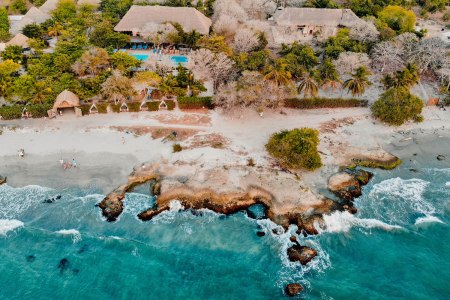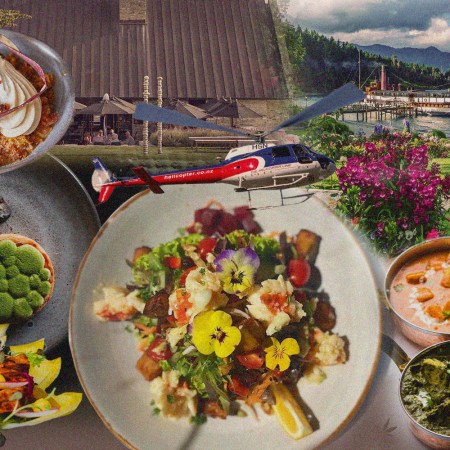Somewhere south of Bogota, about halfway between Granada and Giradot, the mountains opened up from the mist. I left the cool streets of Chico Norte, Bogota’s upscale jewel, in search of a slower pace of life. For more than a year, I had been exploring this side of the Andes mountains, eager to experience the lush wilderness of Colombia’s inlands. When one thinks about visiting Colombia for the first time, they’re likely to jet straight into Medellin, where digital nomads and party boys splurge in El Poblado, or Cartagena, where luxury condominiums rise from the city’s ancient history. For me, however, the main draw of Colombia has always been its capital city. Bogota’s moody reputation rests upon its political divide, its unpredictable weather and its ever-fluctuating element of danger. It’s also the perfect headquarters for exploring some of Colombia’s best landscapes.
East of the capital is La Calera, a popular enclave for wealthy Bogotanos and weekend visitors who prefer luxurious countryside living. Further up the road, you’ll reach Sopo and Guesca, where farmlands surround the famous Lake Guatavita until the road expands into the district of Boyaca. Here, the sun stretches further across the horizon and the temperatures rival Mexico. More often than not, these are the towns of refuge for Bogota’s seven million residents. But further out from the capital, about seven hours southwest on Ruta 40, you’ll find another landscape entirely — one that has attracted visitors from all around the globe.
The region known as the coffee triangle, or Zona Cafetera, has developed into one of the most important coffee-growing regions in the world. The area has done more than any other in Colombia to promote the country’s reputation as a leading coffee producer. It’s attracted aficionados from North America, Europe and Asia. And while my local friends are quick to point out that all regions of Colombia grow coffee, it’s here — between the towns of Pereira, Armenia and Manizales — that the majority of the country’s coffee is produced.
Taking into account that Colombia is the third largest coffee producer in the world, it’s incredible to see that so much of the country’s production exists in such a small region. The area known as Los Santarderes started producing coffee commercially in 1835, and for a long time, the export business was handled by the haciendas, or the “foreign firms,” which influenced an eventual imbalance of power across Colombia’s coffee trade.
How One Woman Resuscitated Colombia’s Forgotten Island of Tierra Bomba
With Blue Apple Beach, owner Portia Hart has led the regeneration of a communityTo fight inequality, the National Federation of Coffee Growing was established in 1927 to protect the interests of small growers while positioning Colombian coffee as the best in the world. Still, even today, more than 500,000 small coffee producers are struggling to make ends meet. To better understand the world of Colombian coffee, I set out to see three of the most recommended family farms near the town of Salento, which, as I would soon witness firsthand, was known for being one of the most picturesque towns in the valley.
High in the Western Andes, I arrived in the southern triangle, bypassing the larger town of Armenia before making my way up to Pereria and crossing east into Cocora Valley. The snake-shaped road jagged downhill, overflowing with walls of thick greenery, submerged in the afternoon of blue skies. I had spent a week in the region and discovered, almost by mistake, that Salento lived up to its reputation. On the phone, I had Timothy Harbour, a Colombian transplant from England, debriefing me on his coffee operations as I arrived into the colonial centre. Old Jeep Willys lined the storefronts, locals hung outside of the mercados and music blared from the inside of second-floor apartments. I followed a string of Jeep Willys up to the first farm house, and from there I ventured deeper into Quindo to discover what made Salento so special.

Don Eduardo
Don Eduardo is a boutique coffee farm that produces pure traditional coffee using eco-friendly techniques. Timothy Harbour — who purchased the 80-year-old coffee farm nearly 20 years ago with his Colombian wife, Cristina — placed second in a sustainable tourism contest run by the Colombian Ministry of Industry, Commerce and Tourism. They’ve also been awarded Traveler’s Choice by TripAdvisor. Harbour promised to resurrect its namesake as one of the region’s best local producers, and they’ve managed to do just that. Coffee tours last approximately three hours and are available daily at 9:30 a.m. and 2:30 p.m.

Las Acacias
Las Acacias Coffee Farm is a traditional family farm promising a unique experience in the world of coffee. When visiting Las Acacias, you’ll actively participate in the coffee procedure and learn about the entire agriculture process. Visitors are welcome to enjoy a cup of coffee and lunch afterwards on their beautiful terrace. Coffee tours last one hour and are available multiple times per day.

El Ocasco
El Ocasco has a more modern approach to family growing. The operation is “shade-grown” and undergoes a mostly organic process that is carefully hand-selected by local single mothers. In the coffee world, double-shading means having different height trees in-between the coffee plantations. This technique improves the soil, air and water quality while slowing down the ripening process that increases sugar and acidity. The result is a more complex body full of flavor. El Ocaso has 70 hectares of land with 12 different species of trees that make up 40% of the plantation shade. The operation also uses 60% organic fertilizer produced in-house.
They offer roasted retail and seasonal coffee online through their e-commerce store, making it an easy grab for those who can’t make the trip to Salento. If you can make it in person, El Ocasco offers coffee tours daily from 9:00 a.m. to 4:00 p.m.
This article was featured in the InsideHook newsletter. Sign up now.

























